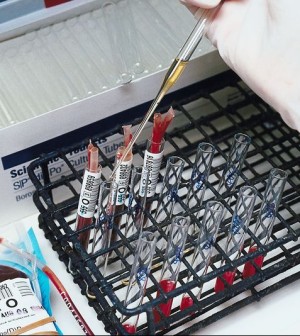- Skip Storing This Everyday Product in the Fridge Door
- Green Tea + B3 Pairing May Boost Brain Health
- Navigating Your Midlife Crisis: Embracing New Possibilities
- City Raccoons Showing Signs of Domestication
- Mapping the Exposome: Science Broadens Focus to Environmental Disease Triggers
- One Week Less on Social Media Linked to Better Mental Health
- Your Brain Changes in Stages as You Age, Study Finds
- Some Suicide Victims Show No Typical Warning Signs, Study Finds
- ByHeart Formula Faces Lawsuits After Babies Sickened With Botulism
- Switch to Vegan Diet Could Cut Your Greenhouse Gas Emissions in Half
Insulin Use, Out-of-Pocket Costs Way Up for Type 2 Diabetes


Laboratory-engineered “insulin analogs” have become the main type of insulin prescribed for people with type 2 diabetes, significantly boosting their out-of-pocket costs, a new study reports.
Insulin use among those with type 2 diabetes increased by about 50 percent over a 10-year period, with most patients receiving pricey insulin analogs that have nearly doubled the amount of money they pay for their prescriptions, said study author Dr. Kasia Lipska, an instructor in medicine at Yale University School of Medicine.
The analogs are molecularly altered forms of human insulin that are designed to be absorbed more quickly or more slowly by the body than human insulin, to avoid dangerous drops in blood sugar levels overnight or to help the body process meals quickly.
“We have made an almost universal transition to the use of the more expensive insulin agents, at least among privately insured patients,” Lipska said. “Do all these patients find the potential benefits of analogs over human insulin worth the cost? Probably not.”
But, Dr. Robert Ratner, chief scientific and medical officer of the American Diabetes Association, said the case could be made that increased use of insulin and insulin analogs shows that diabetics and their doctors are doing a better job controlling the chronic disease.
“The increase in the use of insulin over this time period is actually strongly correlated with other data that show improved glucose [blood sugar] control and decreases in complications, which is a very good thing,” Ratner said.
Many people with type 2 diabetes take insulin to help process blood sugar. If blood sugar levels get too high, a wide range of health problems can set in, leading to damage to the heart, eyes, kidneys and nerves, and other organs.
On Tuesday, the federal government reported that the number of Americans with diabetes rose from 26 million in 2010 to 29 million in 2012 — or 9 percent of the population. Between 90 percent and 95 percent of diabetes cases are the type 2 variety, according to the U.S. National Institutes of Health.
Lipska and her colleagues examined trends in insulin use using data from an administrative claims database of privately insured people from throughout the United States, but with more representation from states in the South and Midwest. The analysis included adults 18 years or older with at least two years of continuous insurance coverage between January 2000 and September 2010.
The researchers found that use of insulin among patients with type 2 diabetes increased from 10 percent in 2000 to 15 percent in 2010, a trend largely attributable to the widespread adoption of insulin analogs.
Among adults using insulin, 96.4 percent filled prescriptions for regular human synthetic insulin in 2000, while 18.9 percent received insulin analogs.
By 2010, those numbers had nearly reversed. About 91.5 percent of people taking insulin filled prescriptions for insulin analogs, while 14.8 percent received human synthetic insulin.
“If the transition has been driven by informed patients who benefit from this, great,” Lipska said. “But I worry that a lot of this transition may have been driven by marketing, not informed patient preferences.”
Out-of-pocket expenditures per prescription increased from a median of $19 to $36 over the 10-year review period, according to the findings published in the June 11 issue of the Journal of the American Medical Association.
“Taking into account the increased use of insulin among patients with type 2 diabetes, we can estimate — with back-of-the-envelope calculations — that out-of-pocket spending on insulin more than tripled from $133 million in 2000 to $432 million in 2010 for every 100,000 patients with type 2 diabetes,” Lipska said.
Severe low blood sugar events declined slightly over the study period, but the difference wasn’t statistically significant, the study authors said.
Ratner argued that the more expensive insulin analogs represent a financial tradeoff between the costs of controlling blood sugar levels versus caring for diabetes complications and emergencies.
Clinical trials have shown that insulin analogs help people with diabetes achieve the same control over their blood sugar levels but with a reduced risk of hypoglycemia, he said.
“We spent $21 billion on glucose-lowering therapies and monitoring in 2010,” Ratner said. “That’s a lot of money. But we spent $71 billion on hospital care. Right now, treating people with medication is less than one-third of the cost of treating their complications in the hospital.”
He added that generic forms of many insulin analogs are in development and will soon reach the market.
“The availability of generic insulin analogs will drive down the cost difference,” he said. “We will no longer have the cost difference, but we will have the clinical benefit.”
More information
For learn more about insulin analogs, visit the University of California, San Francisco.
Source: HealthDay
Copyright © 2025 HealthDay. All rights reserved.










